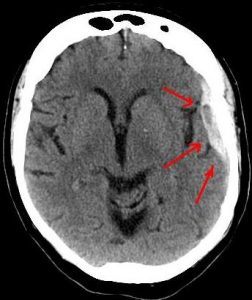Traumatic brain injuries (TBIs) are more common than you might think. The United States Centers for Disease Control and Prevention (CDC) defines a traumatic brain injury (TBI) as “a disruption in the normal function of the brain that can be caused by a bump, blow, or jolt to the head, or penetrating head injury.” The CDC states: “Everyone is at risk for a TBI, especially children and older adults.” If you have had a car crash, slip and fell, hit your head in any incident, then “felt like something was wrong” like headaches, sleeping excessively, impaired thinking or memory, movement (poor balance),
Disease Control and Prevention (CDC) defines a traumatic brain injury (TBI) as “a disruption in the normal function of the brain that can be caused by a bump, blow, or jolt to the head, or penetrating head injury.” The CDC states: “Everyone is at risk for a TBI, especially children and older adults.” If you have had a car crash, slip and fell, hit your head in any incident, then “felt like something was wrong” like headaches, sleeping excessively, impaired thinking or memory, movement (poor balance),  sensation (e.g., vision or hearing), or emotional functioning (e.g., personality changes, depression), you have a traumatic brain injury. This can be a devastating injury and often severely affects the person who’s received the brain trauma. In fact, every day 153 Americans die from a TBI . This very common injury is one of the leading causes of death and disability to every human on the planet. It can have lasting effects not only for individuals and families and the communities those individuals and families with.
sensation (e.g., vision or hearing), or emotional functioning (e.g., personality changes, depression), you have a traumatic brain injury. This can be a devastating injury and often severely affects the person who’s received the brain trauma. In fact, every day 153 Americans die from a TBI . This very common injury is one of the leading causes of death and disability to every human on the planet. It can have lasting effects not only for individuals and families and the communities those individuals and families with.
Causes of TBI: It’s NOT Only a Sports Injury
In the last decade we have read headlines reporting tragic stories of National Football League players involving depression, suicide, uncontrollable rage, spouse battering all linked back to the injuries sustained from the “several concussions” they endured on a weekly basis from repeated trauma to the  brain. There are also ther contact sports athletes who suffer brain injuries from repeated trauma to the brain. We know about these athletes because many are celebrities. However, the vast majority of debilitating and fatal TBIs in the U.S. happen to everyday people in non-sports situations. According to the CDC for the last year data was analyzed:
brain. There are also ther contact sports athletes who suffer brain injuries from repeated trauma to the brain. We know about these athletes because many are celebrities. However, the vast majority of debilitating and fatal TBIs in the U.S. happen to everyday people in non-sports situations. According to the CDC for the last year data was analyzed:
- Falls: Falls are the leading cause of TBI. Falls accounted for 47% of all TBI-related ED visits, hospitalizations, and deaths in the United States. Falls disproportionately affect the youngest and oldest age groups:
- More than half (54%) of TBI-related ED
 visits hospitalizations, and deaths among children 0 to 14 years were caused by falls.
visits hospitalizations, and deaths among children 0 to 14 years were caused by falls. - Nearly 4 in 5 (79%) TBI-related ED visits, hospitalizations, and deaths in adults aged 65 and older were caused by falls.
- More than half (54%) of TBI-related ED
- Struck by or against an object: This is the second leading cause of TBI, accounting for about 15% of TBI-related ED visits,
 hospitalizations, and deaths in the United States.
hospitalizations, and deaths in the United States.
- Over 1 in 5 (22%) TBI-related ED visits, hospitalizations, and deaths in children less than 15 years of age were caused by being struck by or against an object.
- Motor Vehicle Crashes: Among all age groups, motor vehicle crashes were the third overall leading cause of TBI-related ED visits, hospitalizations, and deaths (14%). When looking at just TBI-related deaths, motor vehicle crashes were the third leading cause (19%).
- Intentional self-harm: This is the second leading cause of TBI-related deaths (33%).
Effects of Traumatic Brain Injury Is Often Lifelong
The numbers don’t really tell the story because victims of TBIs do not heal easily or quickly. The profound impact of a TBI can result in persistent, often lifelong problems. Survivors often need extensive rehabilitation and frequently suffer from disorders including:
- Impaired thinking or memory. Even mild cases of TBI result in diminished cognitive performance in both the short and long-term.
- Reduced movement such as limited movement of arms or legs and even paralysis.
- Affected senses. TBIs can cause lessened hearing or vision.
- Emotional functioning including depression and personality disorders.
TBIs can also cause epilepsy and increase the risk of conditions such as Parkinson’s disease, Alzheimer’s disease and other brain disorders.
Even if a survivor recovers fully from the physical trauma of a TBI, there may never be a return to full social independence because of neurobehavioral disability. Many victims must often depend on family and community support for the rest of their lives.
You may Feel Like No One Understands What Has Happened to You.

The family doesn’t understand you

You are accused of faking
The saddest effect of TBI is the one where no one understand your ordeal, the brain-injured person. Your family wants and expects you to “return to normal.” They are worried when you sleep for days after injury, are groggy and hard to wake up after you’ve been sleeping, forget things that just happened or things that you remembered without effort before, you transpose numbers, complain of headaches,

Sure, you have a brain injury.
wear sunglasses because the light hurts your eyes or you get headaches watching television. Your friends also seem impatient for you to “just get over it” or stop “exaggerating your symptoms because you’re trying to get money from a lawsuit.” Nothing could be further from the truth. This can be annoying, upsetting or downright maddening. No one seems to understand. Your coworkers don’t want to do your job for you and want you to return to normal immediately. And, gosh, do you want to. More than anything do you want to go back before your injury. The worst thing is is your family doctor or primary care physician is dismissive of your claims of brain deficits, loss of memory, and ability to think. The truth is they are largely incapable of recognizing this. You need to see a specialist. Fortunately there are some doctors in Florida who understand these injuries. That’s where you need to seek care. Find a concussion doctor. Call a sports medicine doctor’s office and s/he can direct you to a clinic. I can also help here.
In the future, you will have a recovery that can be partial or seemingly full. Deficits you have now are forgotten as your brain heals as best as it can forgetting the mental abilities you had before your brain injury. It takes approximately 24 months in order for your brain to recover from the traumatic damages it sustained. There are some therapies that can result in a better recovery. Your brain’s recovery is largely confined to rest, no television, computer or smart phone screens. You will need to allow your brain to heal. During those 24 months you will need to rest, limit your blue light exposure, eat well, hydrate properly take many other steps to get the best recovery possible.
Get a Lawyer Who Had Clients with Brain Injuries
I understand these injures. I have been practicing personal injury law for more than 31 years. I was a biology minor Florida State University. I got my degree in psychology and have studied the effects of traumatic brain injury over most of the years of my law practice. I have had clients who slept for five days after their brain injuries. I have had clients whose pupils were not the same size after their brain  injury. I have had clients who were forget conversations they had with their children, forgetting even that the child had said anything to them and that they had responded. I have had clients with multiple personality (52 to be exact), cyclothermic, manic-depressive disorders. I have had clients who woke up after their brain injuries speaking in a distinct British accent when they were not British and had never visited a country with English accents, thinking they were African-American when they were Caucasian, not recognizing their family members, uncontrolled anger outbursts and seeing phantom persons. I have clients who have needed heavy psychotropic drugs just focus on and keep their symptoms in check. The devastation caused by damage resulting in a traumatic brain injury is limitless because the human brain is limitless as well.
injury. I have had clients who were forget conversations they had with their children, forgetting even that the child had said anything to them and that they had responded. I have had clients with multiple personality (52 to be exact), cyclothermic, manic-depressive disorders. I have had clients who woke up after their brain injuries speaking in a distinct British accent when they were not British and had never visited a country with English accents, thinking they were African-American when they were Caucasian, not recognizing their family members, uncontrolled anger outbursts and seeing phantom persons. I have clients who have needed heavy psychotropic drugs just focus on and keep their symptoms in check. The devastation caused by damage resulting in a traumatic brain injury is limitless because the human brain is limitless as well.
The human brain is everything we are as humans. when you had a brain injury, your world can be upside down. I understand. If your family friends and the BTS lawyer you hired don’t “get it, ” I do.
S top clicking now if you are injured and searching for an attorney.
top clicking now if you are injured and searching for an attorney.
I am a full-service personalized, personal injury lawyer with a statewide practice in all 67 counties. I have 31 years of experience to put to work for you. Call me so I can answer your questions: 1-800 – 535 – 3002. Email: [email protected] Skype: ScienceCan Facebook: https://www.facebook.com/JSteeleLaw/ Twitter: @JSteeleOlmstead or @FlaBicyleLawyr Whatsapp: J. Steele Olmstead Instagram: jsteeleolmstead.
© 2018 J. Steele Olmstead, P. A., All rights Reserved
